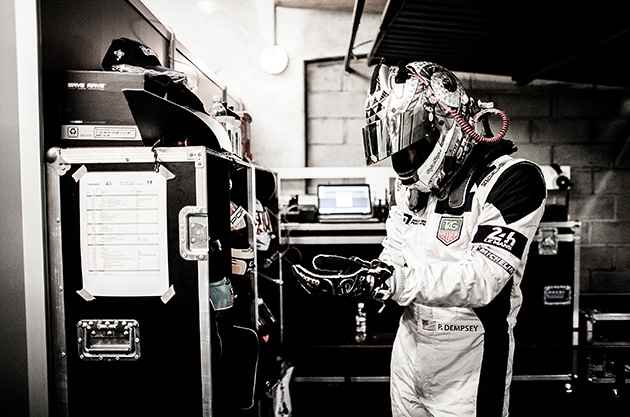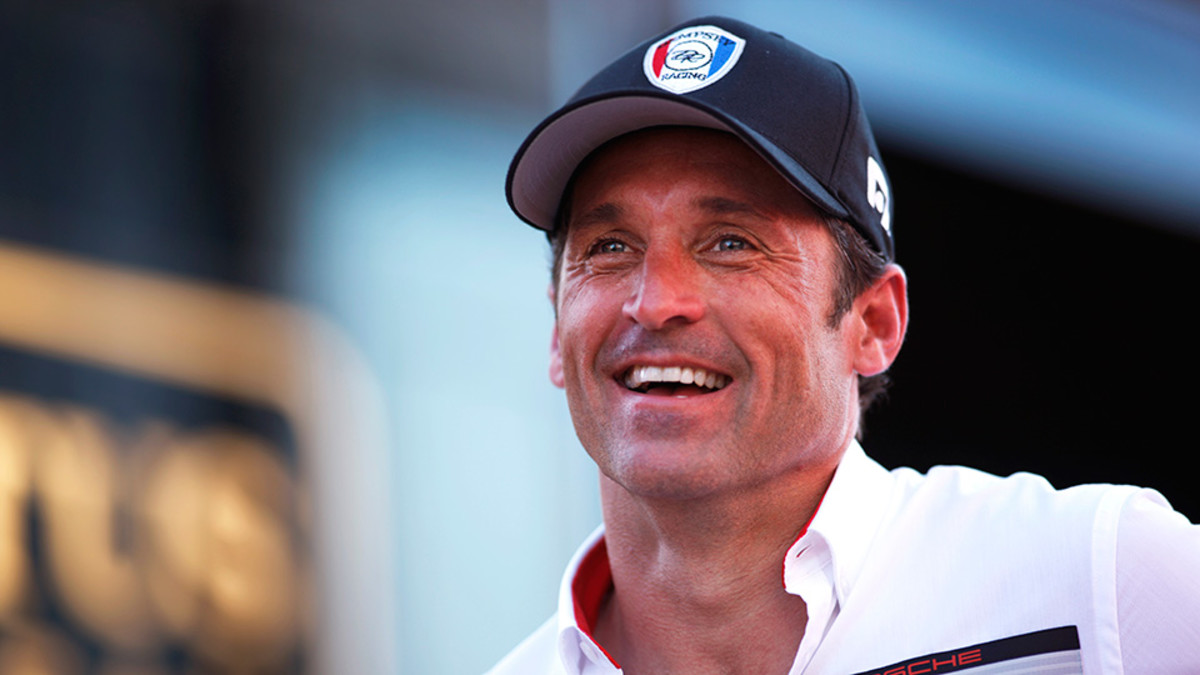Q+A with Actor and Race Car Driver Patrick Dempsey
He is one of the highest paid actors on television, fixing brains and breaking hearts each week on the ABC medical drama Grey’s Anatomy. But when Patrick Dempsey isn’t slipping into his leading role as neurosurgeon Dr. Derek Shepherd, the jewel-eyed, dream boat-haired 48-year-old Hollywood hunk is slipping on a firesuit for a day at the track.
While his list of behind-the-wheel appearances—the 24 Hours of Le Mans, the Rolex 23 at Daytona, the Baja 1000—is not as long as the one bearing his screen work, it’s closing the gap quickly. The Emmy award nominee will added another this weekend when he competed in the Brickyard Grand Prix, a Tudor United Sports Car Championship series road course race that’s sort of an undercard for NASCAR’s Brickyard 400 (which airs Sunday at 1 p.m. E.T. on ESPN).
But before taking his starting position on the grid, Dempsey—who was fresh off of competing in a Porsche Supercup race at the legendary Hockenheimring circuit in Germany—sat down with Edge to talk about his love of racing and the mountain of work that goes into it.
Edge: What’s the biggest thing about racing that you simply can’t fully appreciate just by watching?
Patrick Dempsey: The quality of athleticism that’s needed for a racing driver. Whatever division you’re in, you definitely need to work very hard physically.
Edge: How much training goes into your racing?
PD: Depending on my schedule, I try to work out every day for at least an hour, an hour and a half. I stick with exercises that will keep my heart rate up, strengthen my core, and incorporate elements that work my legs, shoulders, neck and back. It makes a huge difference in the car.
Cycling is a great workout solution; I prefer it to running. (laughs) Go-karting is good too. The stronger you are, the more aggressive you can be—especially on long drives.

Patrick Dempsey of the USA and Dempsey Racing Proton prepares in the garage ahead of his first stint during the Le Mans 24 Hour Race at Circuit de la Sarthe on June 15, 2014 in Le Mans, France.
Vladimir Rys Photography/Getty Images
What are some of the challenges that these longer races present?
PD: Sometimes the bigger battle is one's self than it is with your fellow competitors. Sometimes it’s the conditions. I did a test at Indianapolis a couple weeks ago, and the temperature in the car is well over 100 degrees. You may have a helmet blower to help cool you a little bit, but that takes a lot out of you. But you get used to that. It all goes back to training.
Edge: Speaking of training, how much did you learn from your seat time in Germany?
PD: It was really a great education to see where I was, where my pace was. I hope I can do it again. It was a standing start, the first time I had an opportunity to do that. I really enjoyed myself on it.
Even though I won’t be driving at Indy, it’ll be fun to soak up all the intense competition as well as all the history there. Overall, it’s really exciting to be traveling around the world and racing. It’s such a great community to be a part of. You see a lot of the same people, and all of that camaraderie makes it a wonderful traveling circus.
Edge: Is there anything out there that you’d like to drive that you haven’t yet?
PD: I never tested a Cup car, or a Sprint car. I would love to be able to do that. I think the open wheel stuff for me, I'm a little too old for that.
Edge: You’ve been open about your battles with dyslexia and how it shaped you as a person and an actor. How has it shaped you as a driver?
PD: Inside the cockpit, there's always some kind of activity going on around you. I think because of dyslexia, it does help you process in a faster manner than some people. For me, it's made me more of a hands-on learner when it comes to racing. I understand things better if I can feel it or touch it in some way—which suits racing, where it’s so important to be able to translate what the car is telling you to your engineer.
In many events, I’m competing against a lot of incredibly well educated drivers, and their ability to communicate makes such a difference.

Driver and actor Patrick Dempsey walks past the Infiniti Red Bull Racing garage with his wife Jill Fink before the German Grand Prix at Hockenheimring on July 20, 2014 in Hockenheim, Germany.
Adam Pretty/Getty Images
How difficult was it to gain a fluency in that language?
PD: I think the more time you have behind the wheel, the more you understand what the car is telling you. Things are slowing down. You understand what understeer means and what point in the corner it’s in. Is it in entry, mid-corner or exit? What is the car telling you?
A lot of people I race with have been racing since they were four, five, six, seven, eight years old. They're instincts have been finely tuned over decades, whereas mine are slowly improving with the more I do. Fortunately, I've had tremendous success with Porsche, which has really been supportive of my development. I'm noticing that my feedback and my ability to communicate are approaching the level of my competitors.
Edge: Do you find yourself slipping into that sort of language when you’re, say, accelerating through a highway on-ramp, or doing the school run?
PD: (laughs) I just got back from Germany, where I was on the Autobahn. Where I could actually utilize the horsepower and capability of the car. Here in California, with the amount of traffic that we have, it's really hard and not really appropriate to be pushing the car to the limit. I kind of get my desire to race out on the racetrack, not on the street.
To me, it's far more dangerous to be doing that. It's just not a controlled situation. It's just not appropriate. I leave it on the track. It's just not worth it to me (laughs). And then when people get a little racy and they're not indicating on the freeway, I think it's complete lunacy because they're putting themselves in jeopardy as well as others on the road.
Edge: What about the dangers on the track? Specifically, how much does the type of insurance you’re able to secure dictate the events in which you compete?
PD: Oh, it's certainly more dangerous. I'd never do Indy Lites, nor should I. I think I missed the boat on open wheel racing, although I do appreciate it. Anything with an open cockpit, I am not allowed to drive out.

Actor Patrick Dempsey (C) of the Dempsey Racing, Porsche 911 GT3 RSR is seen talking to media and fans on June 14, 2014 in Le Mans, France.
Andrew Hone/Getty Images
Given your pronounced love for racing, why haven’t you done more motorsports-oriented projects?
PD: It's hard to do a good racing movie. I think Rush did a pretty good job at it. That was a great time and place in racing. But that movie was moderately successful in the U.S. box office ($27 million); I think it did much better abroad ($63 million).
I'm working on a project called The Limit: Life and Death in Formula One's Most Dangerous Era about Phil Hill's F/1 championship run in 1961. I’m working on the pilot with the Sundance channel. That'd be a limited series. I've also got the book The Art of Racing in the Rain up at Universal. But working with a big studio, they’re a little bit slower in their development process compared to Sundance Channel, which operates on a much faster track. I have a lot more optimism in getting that completed than I do The Art of Racing in the Rain.
Edge: Among your recent screen credits is a turn on the animated series “Phineas and Ferb”. “Top Gear” presenters Jeremy Clarkson, Richard Hammond and James May also guest-voiced on that show. When will you be appearing on their show and taking your rightful spin as a Star in a Reasonably Priced Car?
PD: (laughs) Gosh, I don't know! My downtime is so packed and balanced out between the racing program and development and testing and my obligations with Porsche and the Tudor series. There's just not enough time in the day to get everything done. I'd love to be able to do some stuff with them, certainly.





